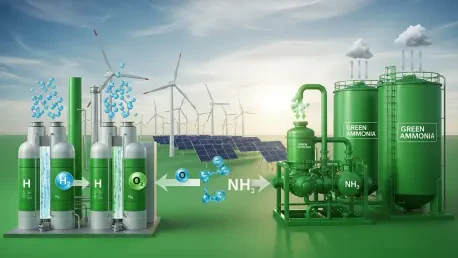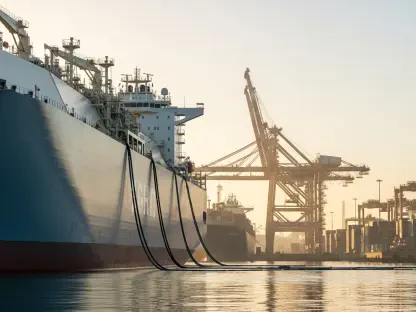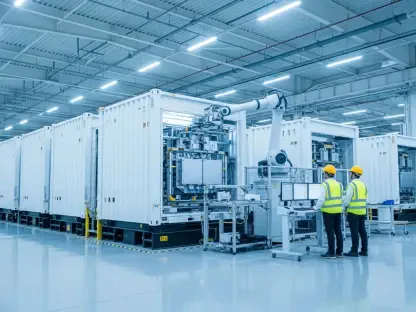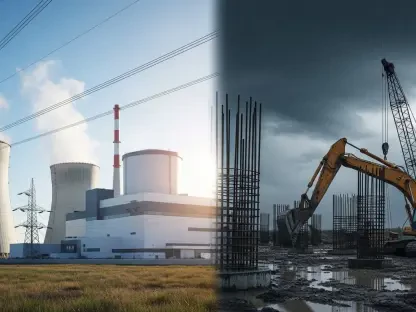What if a single bid could transform an entire nation’s energy landscape? Picture a scenario where sustainable fuel becomes as affordable as its fossil-based counterpart, slashing emissions in industries long deemed impossible to decarbonize. India has turned this vision into reality with a groundbreaking auction result, achieving a record-low tariff for green ammonia at ₹50.75 per kg. This milestone, set by the Solar Energy Corporation of India (SECI), marks a pivotal moment in the journey toward net-zero emissions, capturing global attention and redefining what’s possible in green energy.
A Turning Point for Sustainable Energy
This historic auction result isn’t just a number on a spreadsheet; it’s a beacon of hope for a cleaner future. Green ammonia, produced using renewable energy sources, has emerged as a critical solution for sectors like fertilizers and heavy manufacturing, where direct electrification remains a challenge. The significance of this achievement lies in its potential to accelerate India’s ambitious climate goals, proving that sustainable alternatives can be both viable and cost-competitive.
The importance of this story extends beyond domestic borders. As India cements its role as a frontrunner in green hydrogen derivatives, the ripple effects are felt worldwide. Nations grappling with similar decarbonization challenges are watching closely, eager to learn from this model of innovation and policy-driven progress. This isn’t merely about one auction—it’s about setting a precedent for global energy transitions.
The Auction That Shattered Records
Under SECI’s SIGHT Scheme (Mode-2A), the sixth green ammonia auction delivered a stunning outcome. Jakson Green secured the lowest-ever tariff of ₹50.75 per kg to supply 85,000 tonnes per annum (TPA) to Coromandel International Ltd. in Kakinada, Andhra Pradesh. This figure outdid the previous record of ₹51.80 per kg set by NTPC Renewable Energy Ltd., signaling a rapid decline in costs that few anticipated so soon.
A total tender capacity of 7.24 lakh tonnes annually has been set, with 4.1 lakh tonnes already awarded to various players, including ACME Cleantech Solutions and Oriana Power, at tariffs ranging from ₹51.80 to ₹55.75 per kg. These consistent reductions reflect a maturing market, fueled by fierce competition and growing confidence in the commercial feasibility of green ammonia. Each auction builds on the last, pushing boundaries and challenging long-held assumptions about sustainable fuel costs.
The transparent e-reverse auction process, backed by assured offtake and payment security, has been instrumental in driving these results. Supported by the Ministry of New and Renewable Energy (MNRE) and the Department of Fertilizers, this framework ensures stability for investors while encouraging innovation. The numbers tell a clear story: India is on the cusp of making green ammonia a mainstream energy solution.
Green Ammonia’s Vital Role in Decarbonization
For industries that contribute heavily to carbon emissions, green ammonia offers a lifeline. Unlike grey ammonia, which relies on fossil fuels and releases significant greenhouse gases, this sustainable alternative leverages renewable energy to produce a cleaner fuel. In a country with soaring energy demands and pressing emission reduction targets, its adoption is not just beneficial but essential.
Hard-to-abate sectors stand to gain the most from this shift. Fertilizer production, for instance, is a cornerstone of India’s agricultural economy, yet it remains a major emitter due to reliance on traditional ammonia. By transitioning to greener options, such industries can significantly lower their carbon footprint without sacrificing output or efficiency, aligning with national net-zero ambitions.
Moreover, green ammonia’s versatility extends its impact. Beyond fertilizers, it holds promise as a fuel for shipping and a medium for hydrogen storage, addressing multiple challenges in the energy transition. As costs continue to fall, the barriers to widespread adoption diminish, paving the way for broader systemic change across diverse sectors.
Industry Leaders Weigh In
Voices from the field resonate with optimism about this transformative moment. SECI officials have described the progress as “a game-changer for affordability and scalability,” underscoring green ammonia’s central role in shaping India’s energy future. Their confidence stems from the structured approach of the SIGHT Scheme, which has fostered trust among stakeholders.
Experts at MNRE highlight the importance of policy support in achieving these outcomes. “The e-reverse auction model, combined with guaranteed offtake, has unlocked unprecedented cost reductions,” noted a senior official. This sentiment is shared by industry players like Jakson Green, whose representatives expressed pride in pushing tariffs closer to parity with grey ammonia, a critical step toward market competitiveness.
The consensus is clear: this isn’t a fleeting success but the beginning of a sustained movement. Leaders across sectors agree that with each record-breaking bid, the vision of a decarbonized economy becomes more tangible. Their enthusiasm signals a collective commitment to building on this momentum, ensuring that green ammonia becomes a cornerstone of sustainable development.
Positioning India as a Global Green Energy Leader
The implications of this achievement extend far beyond national boundaries. With tariffs dropping and production scaling, India is well-positioned to lead the global green ammonia market. Strengthening domestic initiatives like the SIGHT Scheme remains crucial, as does maintaining competitive and accessible auctions to attract diverse participants.
International collaboration offers another avenue for growth. Countries such as Japan, Korea, and Germany have shown keen interest in partnering on green hydrogen and ammonia projects. By fostering these alliances, India can not only share expertise but also tap into export opportunities, establishing itself as a key supplier of sustainable fuels on the world stage.
Investment in infrastructure and innovation will be the final piece of the puzzle. Reducing costs further requires advancements in technology and streamlined supply chains. If these elements align, green ammonia could become a flagship export, amplifying India’s influence in the global fight against climate change while bolstering economic growth at home.
Reflecting on a Historic Breakthrough
Looking back, the record-low tariff of ₹50.75 per kg stood as a defining moment that reshaped perceptions of sustainable energy in India. It marked a time when affordability and scalability converged, proving that green ammonia could rival traditional fuels in cost and impact. The success of SECI’s auctions under the SIGHT Scheme demonstrated the power of strategic policy and market mechanisms in driving monumental change.
The path ahead calls for sustained effort and bold action. Policymakers and industry stakeholders need to prioritize expanding production capacities while investing in research to further lower costs. Strengthening global partnerships is also essential to amplify the reach of this innovation, ensuring that the benefits of green ammonia extend to every corner of the world.
Ultimately, this chapter in India’s energy story serves as a reminder of what is possible with vision and collaboration. The challenge now is to maintain this trajectory, turning a single auction triumph into a lasting legacy of environmental stewardship and economic resilience for generations to come.









